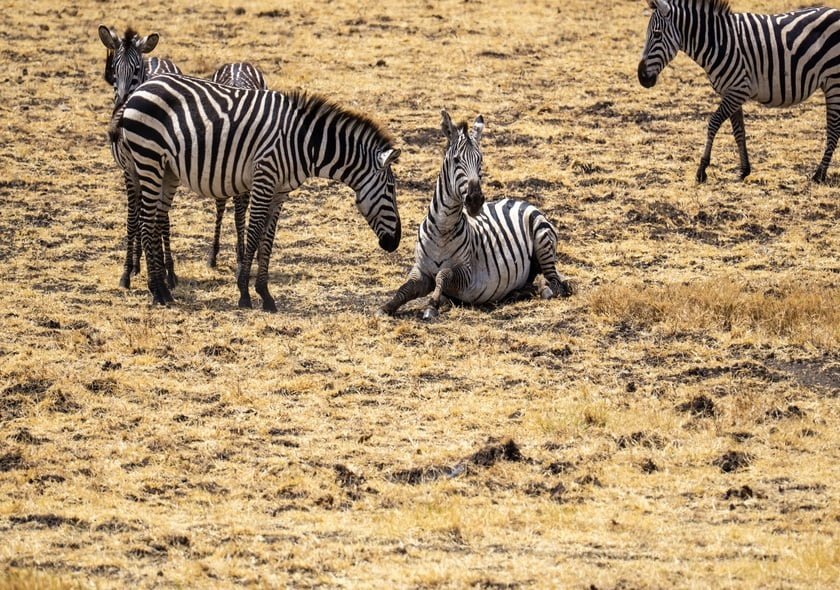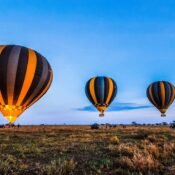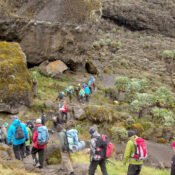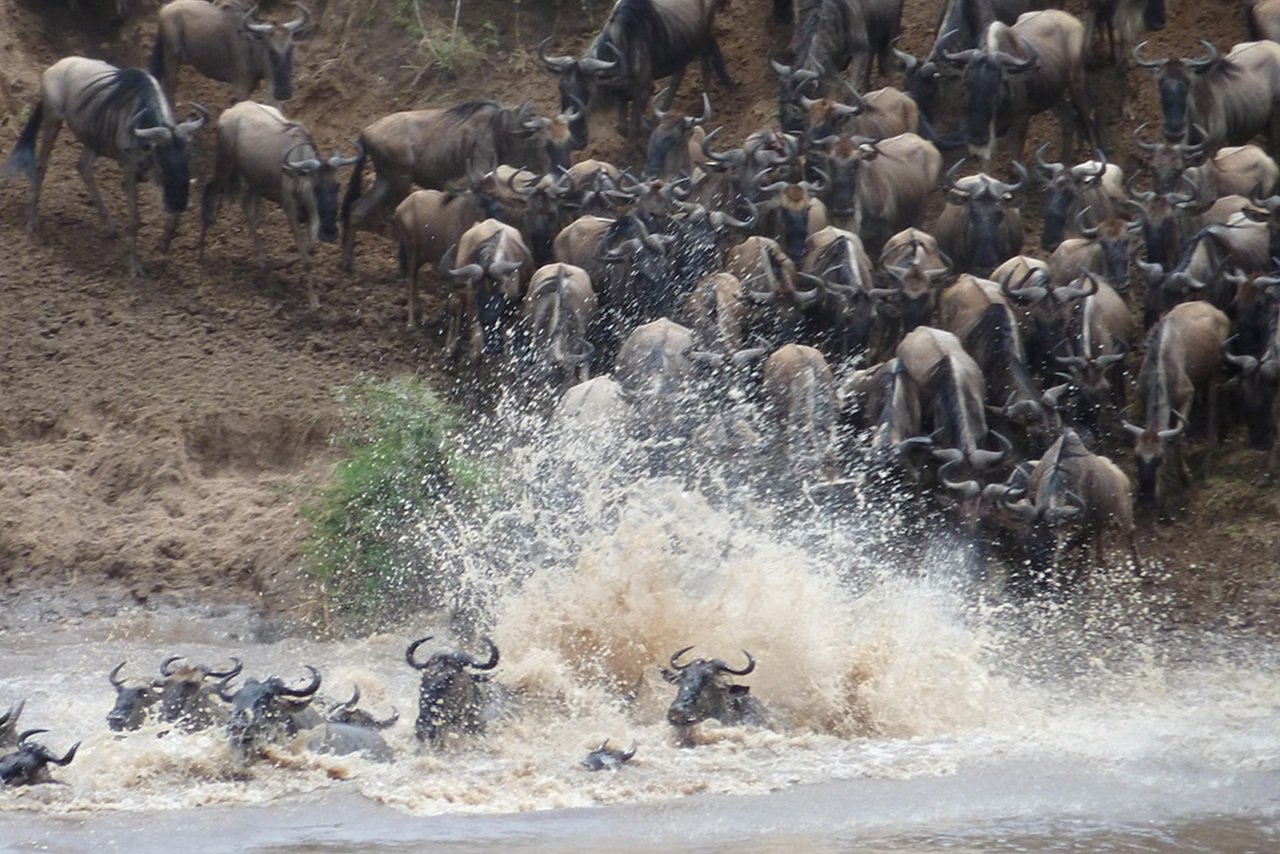
Serengeti Migration Safari Guide
The Ultimate Serengeti Migration Safari Guide
Embark on an unforgettable journey through one of the most spectacular wildlife events on the planet, the Great Migration of the Serengeti. With Tanzania Beauty Safaris as your expert guide, you’ll witness nature’s most dramatic theatre as over two million animals traverse the vast plains in search of life-giving rains and fresh pasture. This annual movement, driven by survival and ancient instinct, is an awe-inspiring dance between predator and prey, water and dust, birth and death.
Book this Tour:- 5 Day Great Migration Safari – Serengeti & Ngorongoro Crater
The Great Migration isn’t just about movement, it’s a living, breathing cycle that unfolds with remarkable precision and rhythm across the seasons. From the lush southern plains where thousands of wildebeests give birth each day, to the perilous river crossings in the north, every chapter of this journey offers its own breathtaking encounters.
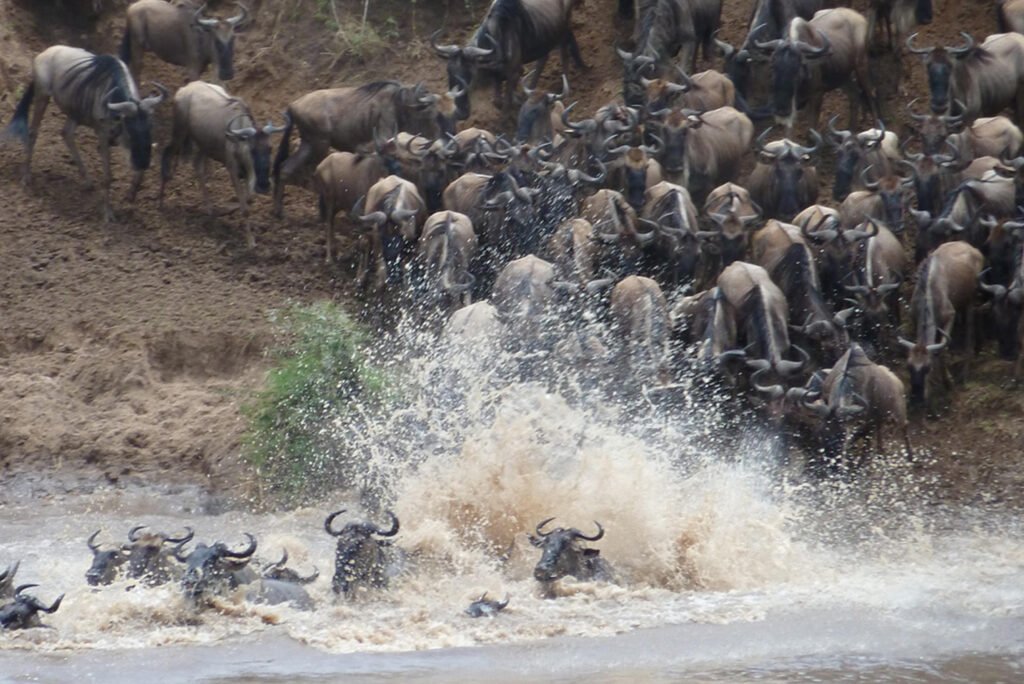
Whether you’re an avid wildlife photographer, a first-time safari-goer, or someone who’s dreamed of standing amidst the thunder of hooves on the Serengeti, this guide will walk you through what to expect, where to go, and when to witness the different stages of the migration. Prepare to discover a world where nature rules, drama unfolds daily, and every sunrise holds the promise of something extraordinary.
November to Mid-March: The Calving Season in Southern Serengeti and Ndutu
As November arrives, the first signs of the migration stir in the eastern Serengeti. The herds begin their movement southward from Kenya’s Masai Mara, drawn by the short rains that bring life back to the savannah. By late November, the wildebeests, along with vast numbers of zebras and gazelles, begin to populate the southern Serengeti and the fertile plains of Ndutu, a region famed not only for its wildlife density but also for its scenic beauty.
This is a time of renewal. The landscape, once golden and dry, turns lush green almost overnight. Storm clouds gather in the distance, casting dramatic light across the plains. Wildebeests march in long, graceful lines, calves still unborn but growing inside their mothers. The air hums with anticipation.
By mid-December and especially throughout January and February, the miracle of life takes centre stage. Nearly 500,000 wildebeests are born during this short window, and it’s not uncommon to witness several births during a single game drive. The open plains, free of thick brush, offer protection for the newborns, giving them space to learn to walk, run, and survive within minutes of birth.
Yet, with new life comes danger. Predators such as lions, leopards, hyenas, and cheetahs follow closely. This creates a thrilling and raw spectacle of survival. Cheetahs often use termite mounds for elevated vantage points, stalking newborn calves as they stray from the herd. Hyenas test the perimeter, waiting for opportunity. The circle of life is vivid, real, and emotional.
February is the peak of the calving season, offering exceptional opportunities for photographers and wildlife lovers. Beyond the wildebeests, travellers may also spot baby zebras, gazelles, warthogs, and even the occasional young giraffe. The abundance of prey leads to dramatic predator interactions, making this a top choice for those seeking dramatic moments without the crowds of peak season.
The weather, though humid, is largely cooperative. Short rains occur mostly at night, keeping the daytime ideal for exploration. This is also Tanzania’s “Green Season,” offering verdant backdrops, colourful birdlife, and reduced tourist numbers. The photographic conditions are superb, stormy skies, golden light, and green grasslands make for powerful compositions.
For a complete calving safari experience, we recommend at least 3–5 nights in the Ndutu region. Lodges and tented camps in this area are well-situated for day-long explorations, often placing you in the heart of the action at sunrise.
Mid-March to April: Westward Transition and Rainy Serenity
As the end of March approaches, the drama of calving gradually gives way to movement once more. The calves, now a few weeks old, are stronger, faster, and better prepared for the arduous journey ahead. The herds begin to stretch out again, spreading across the southern and southwestern Serengeti, with the densest concentrations shifting toward the Moru Kopjes and the Kusini area.
This time of year, marks the beginning of the long rains. While this may deter some travellers, those who do visit are treated to one of the Serengeti’s most peaceful and evocative seasons. The scenery is almost dreamlike, rolling green hills, wildflowers in bloom, and distant thunder echoing across the savannah.

Though the migration is less condensed during this period, there’s a quiet beauty in the scattered herds. Young calves play and run, zebras travel in synchronized motion, and elephants wander among the acacias. Predator sightings remain frequent, especially near the woodlands where cover allows for stealth.
Photography becomes a game of patience and reward. Rainstorms may roll through briefly, but they give way to glowing skies and rainbow-lit horizons. With fewer safari vehicles in the parks, you may have intimate wildlife encounters without interruption.
April may not offer the blockbuster events of river crossings or mass birthing, but it provides a more introspective safari, perfect for travellers who seek solitude, space, and authenticity. Staying in the southern and western reaches of the park during this time allows for easy tracking of the herds as they transition northward.
May to June: The Grummet River Crossings in the Western Corridor
By early May, the herds have gathered momentum. Now hundreds of thousands strong, they flow into the western Serengeti, moving towards the Grumet River. This is where the drama rises once more. Though not as famous as the Mara, the Grumet crossings are wild, intense, and deeply captivating.
The river, flanked by dense forests and dotted with fig trees, snakes through the western corridor of the park. It’s not particularly wide, but it teems with Nile crocodiles, some stretching up to 20 feet in length. As the wildebeest’s approach, the stakes become clear.
Crossing the Grumeti is a test of instinct. The animals hesitate, pacing along the banks, sometimes turning back, sometimes jumping in masse. Some make it. Others do not. For those lucky enough to witness a crossing here, the experience is unforgettable, raw, chaotic, and emotional.
June is the peak month for these events. The herds are compact, the calves are stronger, and the predators more focused. Lions and leopards trail the migration through the forest fringes. Meanwhile, birdlife flourishes in the area, kingfishers, herons, and fish eagles add an avian dimension to the spectacle.
The weather during May and June is transitional. While May can still bring lingering showers, June generally marks the return of drier days and cooler temperatures, making it a comfortable and productive time for safari. Lodges in the western Serengeti are well-positioned to access both game-rich plains and the riverbanks, offering an ideal base for 2–4 nights of exploration.
July to October: The Mara River Crossings and the Northern Drama
This is the moment that safari dreams are made of. From July through October, the Great Migration reaches its climax in the northern Serengeti and the bordering Masai Mara. The Mara River stands as the final and most dangerous barrier in the wildebeests’ journey, a churning gauntlet of fast-flowing water, steep banks, and waiting crocodiles.
The scale of the crossings here is epic. Tens of thousands of animals can gather at the river’s edge, their calls filling the air as dust rises and tension builds. They stall. surge. They hesitate again. Then suddenly, one jumps. And then another. And the chaos begins.
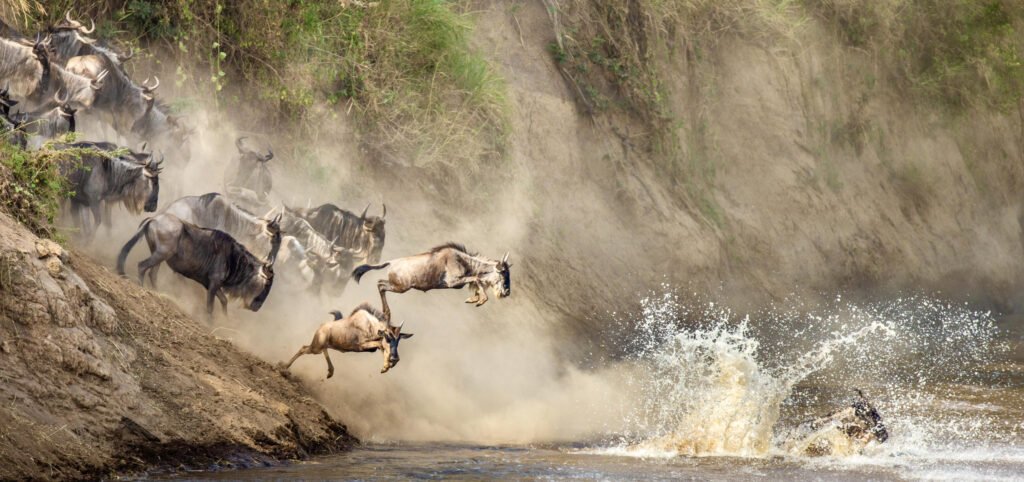
Some are swept away. Others break legs. Many make it to the other side. The sense of survival is tangible, and witnessing a Mara River crossing in person is an emotional and exhilarating experience that stays with you for life.
The most reliable period to catch a crossing is from mid-July to late September. During this window, the herds are mostly in the Kogatende and Lamai regions of the Serengeti, crossing back and forth between Tanzania and Kenya as they follow the rains. However, October can also provide opportunities as the migration begins to head south again.
Beyond the river crossings, the northern Serengeti is a wildlife haven in its own right. The landscape is varied, with rolling hills, acacia woodlands, and open savannahs. Lion prides patrol the valleys. Cheetahs stalk from termite mounds. And leopards rest in trees along the river.
The dry season during these months ensures clear skies, warm days, and cool nights, ideal conditions for safari. Visibility is excellent, and the lack of vegetation makes it easier to spot elusive predators. Due to the unpredictability of crossings, we recommend a stay of at least 3–4 nights in the northern Serengeti to maximize your chances.
While witnessing a crossing is never guaranteed, extended time in the area dramatically increases your odds. Some travellers are lucky enough to see multiple crossings in one day. Others wait patiently and are rewarded by the sheer anticipation and build-up. Either way, the experience is deeply moving.
Why Travel with Tanzania Beauty Safaris?
At Tanzania Beauty Safaris, we don’t just take you to the Serengeti, we immerse you in its stories. With local expertise, personalized service, and a deep passion for conservation, we craft migration safaris that align with your travel goals, budget, and sense of adventure.
Our expert guides know the terrain, the timing, and the behaviour of the wildlife. Whether you’re hoping to photograph a dramatic crossing, observe lions on the hunt, or simply watch a sunrise over the savannah with a cup of fresh Tanzanian coffee in hand, we’re here to make it happen.
Choose from our handpicked collection of safari itineraries, ranging from 5-day calving safaris in Ndutu to 9-day northern Serengeti migration adventures. Whether you prefer luxury tented camps, intimate lodges, or mobile camps that follow the herds, we’ll help you find the perfect setting for your journey.
Conclusion: Witness Nature’s Greatest Journey
The Great Migration is more than a safari, it’s a front-row seat to the rhythm of the wild. It’s the thunder of hooves at dawn. The quiet moment when a calf first stands. The splash of water as thousands leap into the unknown. The chase, the survival, the rebirth.
No matter when you travel, the Serengeti offers something truly special. From the soft rains of the south to the roar of rivers in the north, every moment is a reminder of the beauty, power, and resilience of nature.
Let Tanzania Beauty Safaris be your guide to this once-in-a-lifetime adventure. Contact us today to begin planning your ultimate Migration Safari and step into the heart of Africa’s greatest wildlife story.
All Categories
Recent Posts
The Best Time to Go on a Safari in Tanzania
Tanzania Travel Safety Update 2025
How Long Does It Take to Climb Mount Kilimanjaro?
